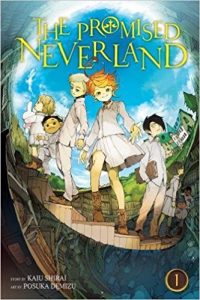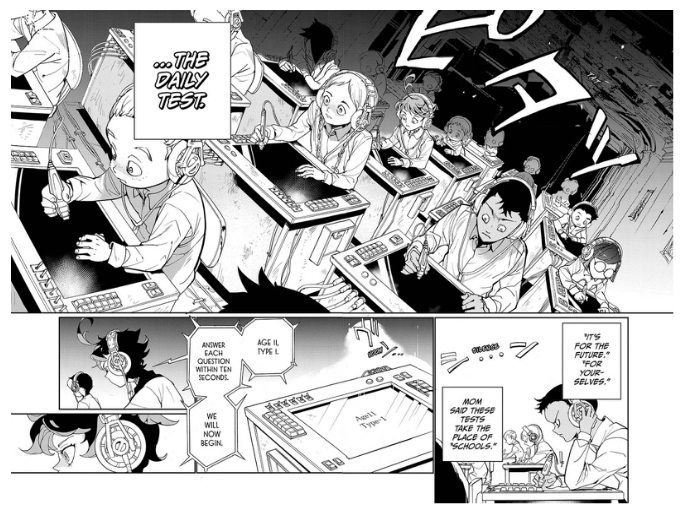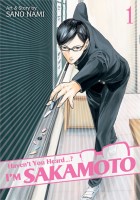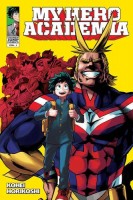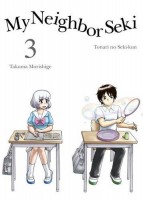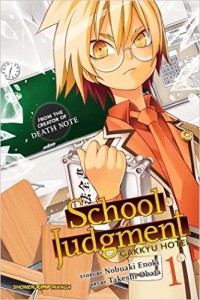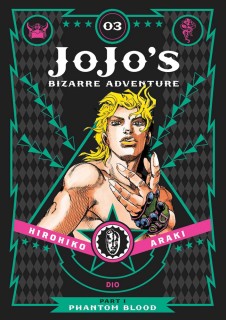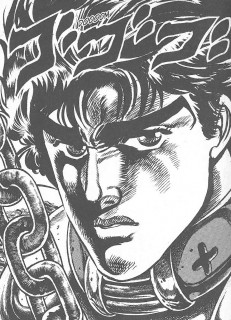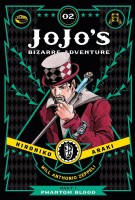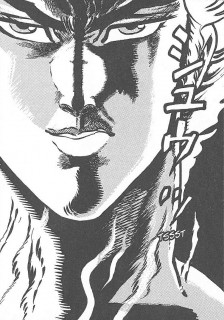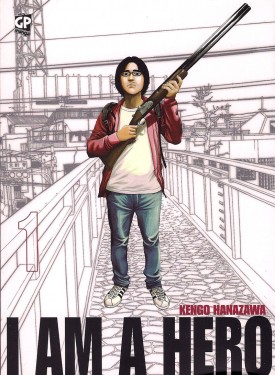Just a word to the wise: it’s impossible to discuss either Neverland or Spoon without divulging a few plot details, so be mindful if you’re the kind of person who hates–HATES–spoilers. Caveat lector!
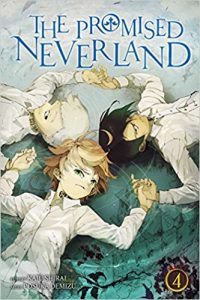 The Promised Neverland, Vol. 4
The Promised Neverland, Vol. 4
Written by Kaiu Shirai, Illustrated by Posuka Demizu
Translated by Satsuki Yamashita
VIZ Media
Rated T+, for older teens
One of the pleasures of reading The Promised Neverland is its crack pacing: Kaiu Shirai and Posuka Demizu have a knack for the perfectly timed reveal and the pulse-pounding action sequence. Volume three was a rare misstep for the series, saddled with too many contrived plot twists, but volume four is a return to form, briskly setting the kids’ escape in motion. The story occasionally flags when Emma, Ray, and Norman explain the finer details of their plan to one another, but these moments serve an essential dramatic purpose, helping us appreciate how perilous their journey will be. These conversations also remind us how much the principal trio rely on one another for emotional support, a point driven home by the authors’ decision to sacrifice one of the main characters. (And I mean a main character, not a red shirt.)
Perhaps the most surprising thing about The Promised Neverland is its feminist subtext. In the final pages of volume three, Krone reveals that the brightest orphan girls are groomed for house mother positions. The full horror of this arrangement, however, only becomes apparent in volume four. In a few suggestive images, Demizu vividly conveys the grotesque sacrifices that Gracefield Manor’s female residents make in order to survive their twelfth birthday. A brief interlude set in a factory evokes the grim spirit of The Handmaid’s Tale, imagining a world in which young women are cruelly exploited for their fertility, then coerced into perpetuating the very system that oppresses them.
I know — I’m making The Promised Neverland sound like Terribly Serious Reading, but rest assured it isn’t. The story is, at bottom, a juicy prison drama in which the jailers are actual monsters and the prisoners pint-sized MacGuyvers. Though the subtext enriches the narrative, inviting multiple readings, the story never feels like an obvious parable about factory farming or reproductive rights. Recommended.
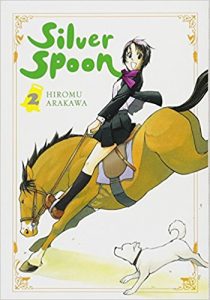 Silver Spoon, Vol. 2
Silver Spoon, Vol. 2
Written and Illustrated by Hiromu Arakawa
Translated by Amanda Haley
Yen Press
Rated T, for teens
After an introductory volume in which Hachiken (a) fell face-first into poop (b) insulted his classmates repeatedly (c) joined the equestrian club just to impress a girl and (d) realized that the piglet he was raising would soon be bacon, volume two affords him a rare moment of grace. The students’ discovery of an abandoned brick oven prompts them to make pizza — something only Hachiken knows how to do. The act of cooking for so many people forces Hachiken to improvise, rather than plan, forcing him outside his academic and social comfort zone — and making his brief turn in the spotlight even more satisfying.
Lest Hachiken’s triumph seem a little too tidy, the rest of volume two sees him reverting to bumbling city slicker, as he gets lost in the woods looking for cell phone reception, gags at the sight of a newborn calf, and, yes, falls face-first into another pile of manure. Hiromu Arakawa sells these moments with her trademark over-the-top reaction shots; no one can distort or bend a human face with the same verve as Arakawa, who turns every setback, humiliation, and surprise into an opportunity to draw rivers of snot and tears. Though she excels at slapstick, Arakawa tempers the jokes with moments of real drama that make Hachiken realize just how much Komaba and Mikage’s families struggle to keep their modest dairy farms afloat. It’s these quieter moments that remind us just what a capable storyteller Arakawa really is, and make Silver Spoon more than just a gag manga with farm animals. Recommended.

